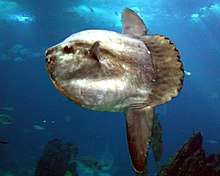Mola (fish)
A sunfish (or mola) is any fish in the Mola genus (family Molidae). The fish develop their truncated, bullet-like shape because the back fin, with which they are born, never grows. Instead, it folds into itself as the creature matures, creating a rounded rudder called a clavus. Mola in Latin means "millstone" and describes the ocean sunfish's somewhat circular shape. They are a silvery color and have a rough skin texture.
| Mola | |
|---|---|
 | |
| Mola mola | |
| Scientific classification | |
| Kingdom: | Animalia |
| Phylum: | Chordata |
| Class: | Actinopterygii |
| Order: | Tetraodontiformes |
| Family: | Molidae |
| Genus: | Mola Kölreuter, 1766 |
The mola is the heaviest of all the bony fish, with large specimens reaching 14 ft (4.3 m) vertically and 10 ft (3.0 m) horizontally and weighing nearly 5,000 lb (2,300 kg). Sharks and rays can be heavier, but they are cartilaginous fish.
Mola are found in temperate and tropical oceans around the world. They are frequently seen basking in the sun near the surface and are often mistaken for sharks when their huge dorsal fins emerge above the water. Their teeth are fused into a beak-like structure, and they are unable to fully close their relatively small mouths.
Ocean sunfish can become so infested with skin parasites, they will often invite small fish or even birds to feast on them. Sunfish will even breach the surface up to 10 ft (3.0 m) in the air, in an attempt to shake the parasites.
They are clumsy swimmers, waggling their large dorsal and anal fins to move, and steering with their clavus. Their food of choice is jellyfish, though they will eat small fish and huge amounts of zooplankton and algae, as well. They are harmless to people, but can be very curious and will often approach divers.
Their population is considered stable, though they frequently are snagged in drift gill nets and can suffocate on sea trash, like plastic bags (which resemble jellyfish).
Species
There are currently 3 recognized species in this genus:[2][3]
- Mola mola (Linnaeus, 1758) (Ocean sunfish)
- Mola alexandrini (Giglioli, 1883) (Southern sunfish)
- Mola tecta Nyegaard et al., 2017 (Hoodwinker sunfish)
References
- Sepkoski, J. (2002). "A compendium of fossil marine animal genera". Bulletins of American Paleontology. 364: 560.
- Matsuura, K (2014). "Taxonomy and systematics of tetraodontiform fishes: a review focusing primarily on progress in the period from 1980 to 2014". Ichthyological Research. 62 (1): 72–113. doi:10.1007/s10228-014-0444-5.
- Nyegaard, Marianne; Sawai, Etsuro; Gemmell, Neil; Gillum, Joanne; Loneragan, Neil R.; Yamanoue, Yusuke; Stewart, Andrew L. (19 July 2017). "Hiding in broad daylight: molecular and morphological data reveal a new ocean sunfish species (Tetraodontiformes: Molidae) that has eluded recognition". Zoological Journal of the Linnean Society. 182 (3): 631–658. doi:10.1093/zoolinnean/zlx040.